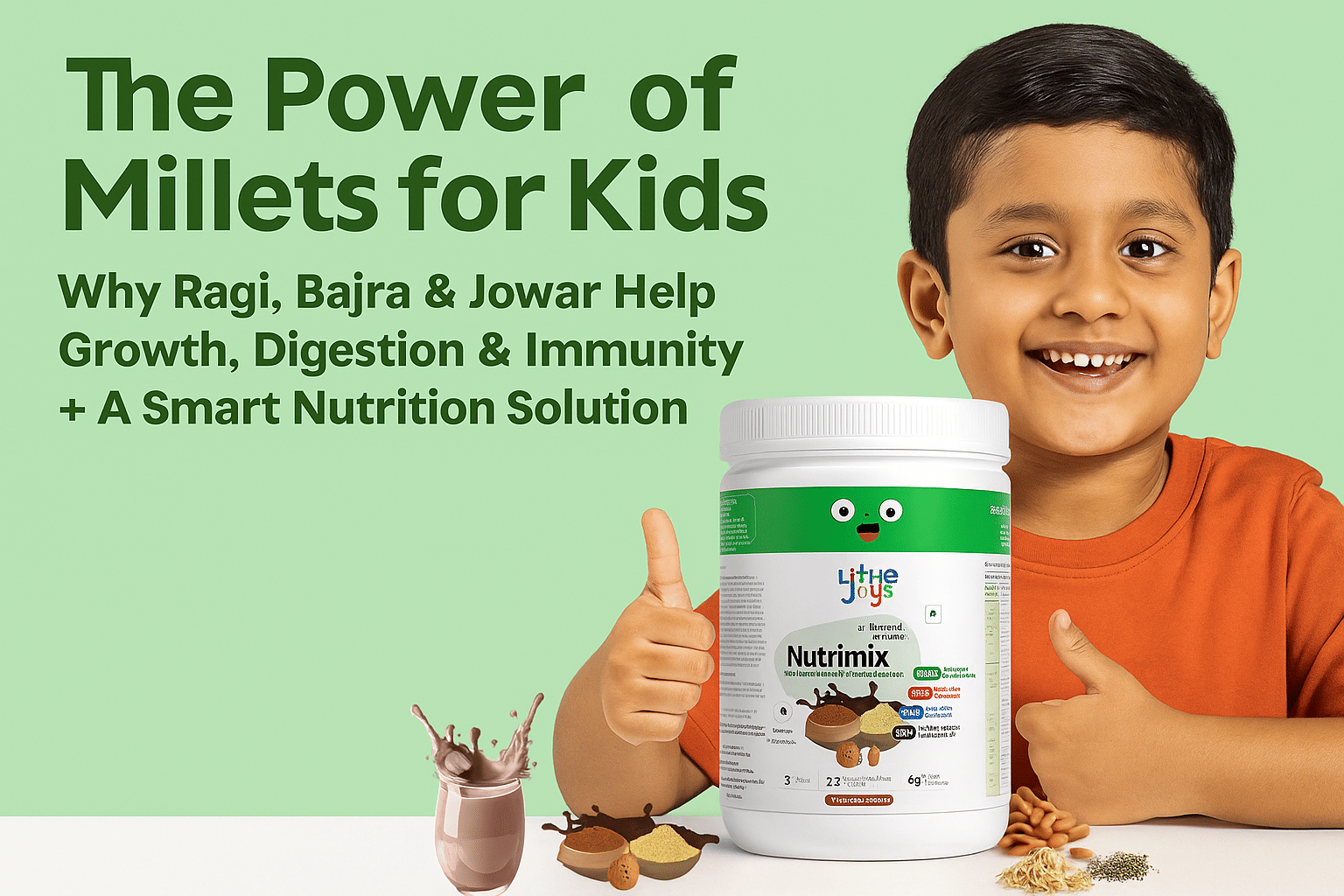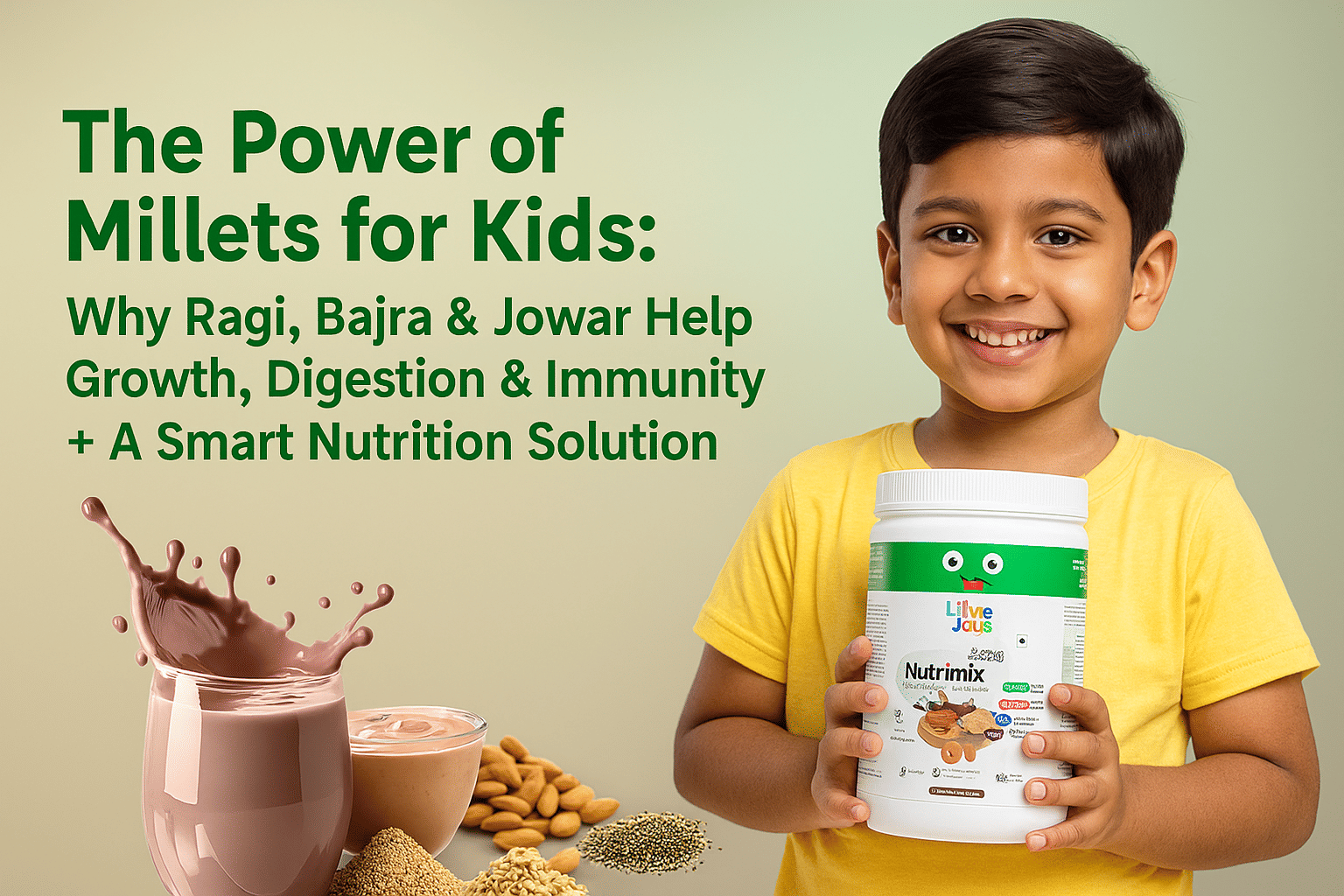The Power of Millets for Kids: Why Ragi, Bajra & Jowar Help Growth, Digestion & Immunity + A Smart Nutrition Solution
Millets like ragi, bajra and jowar are nutrient-rich superfoods for kids — packed with calcium, iron, protein and fiber. Explore their benefits for growth and immunity, plus simple ways to add them to your child’s meals with Nutrimix.

The Power of Millets: Why Ragi, Bajra & Jowar Are Great for Kids
Growing children need more than just calories—they need protein, vitamins, minerals, fiber, and immunity support. Millets — especially ragi, bajra, and jowar — are ancient grains that pack a surprising nutritional punch. In this article, we’ll do a deep dive into the nutrients in millets, how they help growth, digestion, immunity, and how you can integrate them (even via a ready mix) in your child’s diet.
We’ll also introduce Little Joys Nutrimix (a millets-based kids nutrition powder) as a gentle, practical solution — not as a hard sell, but as a helpful tool in your parenting toolkit.
Why Millets Matter for Children’s Nutrition
What are millets? A brief primer
Millets are small-seeded grains (cereals) that include varieties like finger millet (ragi), pearl millet (bajra), sorghum (jowar), as well as “small millets” such as little millet, kodo millet, foxtail, etc.
Unlike major staples like rice and wheat, millets often offer higher micronutrient density, fiber, and plant-based protein.
- Millets are small-seeded grains (cereals) that include varieties like finger millet (ragi), pearl millet (bajra), sorghum (jowar), as well as “small millets” such as little millet, kodo millet, foxtail, etc.
- Unlike major staples like rice and wheat, millets often offer higher micronutrient density, fiber, and plant-based protein.
- They tend to have a lower glycemic index, making them a steadier energy source.
Nutrient profile of ragi, bajra, jowar — what children gain
- Ragi uniquely offers very high calcium among grains, which is helpful for bone growth.
- Bajra and jowar contribute more in terms of protein and iron (important for haemoglobin) compared to many refined grains.
- All these millets are gluten-free, rich in fiber, and have favorable micronutrient profiles.
How Millets Support Kids’ Growth, Digestion & Immunity
Promoting healthy growth & bones
- The calcium in ragi helps with bone mineralization, teeth development, and muscular strength.
- The grains also provide magnesium, phosphorus, zinc, vitamin B complex which assist in cell division, tissue growth, and enzyme functions.
- The protein (plant-based) helps in muscle repair and organ development.
Digestive health & appetite regulation
- Dietary fiber in millets supports healthy bowel movement, slower gastric emptying, and better microflora.
- Because millets have a low glycemic index (slow-release carbohydrate), they help maintain stable blood sugar, which can prevent energy crashes and sudden hunger spikes.
- For fussy eaters, millet porridge or malted millet preparations are easier to digest and gentler on the tummy.
Immunity, antioxidants & micronutrients
- Millets are rich in iron, zinc, and magnesium, which are critical for immune cell formation and function.
- They also contain phenolic compounds, flavonoids, and antioxidants which help in fighting oxidative stress and inflammation.
- The B-vitamins (niacin, riboflavin, folate) support energy metabolism and cellular repair.
Why combining different millets matters
No single grain has everything. A mix of ragi + bajra + jowar (or adding small millets) gives a more balanced micronutrient profile and mitigates any shortcomings of one variety.
Practical Challenges & Where a Nutrimix Approach Helps
Even though millets are excellent, there are practical parenting challenges:
- Time & convenience: Grinding, soaking, roasting and preparing millet blends daily is labor-intensive.
- Taste & acceptability: Some children resist the flavor or texture differences.
- Ensuring correct ratio & fortification: To get optimal micronutrients, you need precise blending and sometimes fortification (iron, vitamin D, etc.).
- No refined sugar / no artificial additives: Many commercial drink powders add sugar or preservatives, which parents try to avoid.
This is where a thoughtfully formulated kids nutrition powder can help — not to replace real food, but as a supportive option when needed.
Introducing Little Joys Nutrimix: A Millet-based Kids Nutrition Option
What is Little Joys Nutrimix / kids nutrition powder?
Little Joys Nutrimix (or Nutrimix by Little Joys) is a millet and nut-based milk mix / protein mix for kids designed to combine the benefits of ragi, bajra, jowar and nuts (almond, cashew, etc.), along with added vitamins and minerals.
It is positioned as a no sugar / no refined sugar milk mix / healthy milk powder for kids — meaning zero refined sugar, no artificial flavors or colors, and no preservatives.
How Little Joys Nutrimix complements millet benefits for kids’ daily nutrition
- The base millets provide natural fiber, calcium, iron, magnesium, and B-vitamins that support growth and digestion.
- The nut component (almond, cashew, walnut) adds healthy fats, plant protein, and micronutrients like vitamin E.
- Fortified with vitamin D, zinc, and other micronutrients that help support immune function
- Easy to mix into milk — hot or cold milk, for ages 2–6 yrs and 7–12 yrs, designed to suit common nutritional needs of growing children.
- Because it’s a millet milk mix for kids, it maintains the benefits of millets but in a format that’s accessible and quick for many busy parents.
Suggested use & cautions
- Use as a supplement (not full meal replacement).
- Mix in milk (dairy or plant based) or warm water to make a shake or malt.
- Monitor for allergies (nuts).
- Rotate with whole food millet preparations (rotis, porridge, khichdi) so the child still learns to eat real food.
- Adjust serving for age (2–6 yrs, 7–12 yrs) to avoid overfeeding calories.
Tips to Integrate Millets / Nutrimix in Kids’ Diets
Recipes & serving ideas'
- Millet porridge / kheer: Use ragi or combination with dates/jaggery + milk.
- Millet dosa / idli / upma: Mix in a portion of ragi / jowar flour with rice/wheat or replace entirely.
- Millet rotis / bhakri: Use bajra / jowar flour or blend with regular atta.
- Millet khichdi / one-pot: Use little millet or foxtail / bajra as rice substitute.
- Millet cookies / laddoos: Add millet flours + nuts + jaggery to make snacks children enjoy.
- Daily shake: Use Little Joys Nutrimix in milk once a day as a supportive dose.
Gradual introduction & acceptance
- Start with small proportions (10–20%) mixed into familiar dishes so children adjust taste gradually.
- Use flavors they like (mild vanilla, chocolate) to mask unfamiliar grain notes.
- Allow them to help (stirring, mixing) — involvement can reduce resistance.
- Serve with favorite sides, fruits, or yoghurt to encourage finishing.
Balancing overall diet
- Ensure sufficient protein from pulses, eggs, dairy, meat (if non-vegetarian) to complement millet protein.
- Pair millets with vitamin C rich fruits/vegetables (like citrus, tomato) to enhance iron absorption.
- Monitor intake of fats & sugar — nut mixes often already contribute energy, so don’t overdo extra fats or sweeteners.
- Rotate with other whole grains — diversity is key.
Common Questions from Parents (FAQ)
Q: Are millets safe for all children (e.g. allergies, digestion)?
Yes, millets are generally safe, naturally gluten-free, and well tolerated. But if your child has nut allergies or digestive issues, introduce slowly. Always monitor the first few days.
Q: Can millet mixes like Nutrimix replace meals?
No, they are designed as a supplement or booster, not a full meal substitute. Real whole-food meals are still essential for chewing practice, variety, and developing taste.
Q: Will my child gain too much weight with a nutrition powder?
Not necessarily — by choosing a no sugar / no refined sugar mix and monitoring portion size, you can avoid excess calories. Also ensure physical activity and balance with total diet.
Q: When should I use Nutrimix vs raw millets?
Use raw millets (rotis, porridges) most of the time, and Nutrimix as a “backup” in times of low appetite, travel, or as a convenient shake option.
Q: How do I avoid over-promotion / overuse?
Limit the mix usage to once per day max, always rotate with whole grains, and present it as a helper (not magic). Encourage real food first.
Recap & Parenting Takeaways
- Millets (ragi, bajra, jowar) are nutrition powerhouses — offering calcium, iron, fiber, plant protein, and a spectrum of minerals.
- These nutrients directly support growth, digestion, immunity, bone health, and balanced energy levels in children.
- A millet-nutrition powder (e.g. Little Joys Nutrimix) can act as a bridge between traditional home cooking and the convenience many parents need — without resorting to heavily sweetened commercial mixes.
- Use the mix judiciously, rotate with whole millet meals, adjust for age, and integrate recipes to maintain taste appeal and food diversity.

